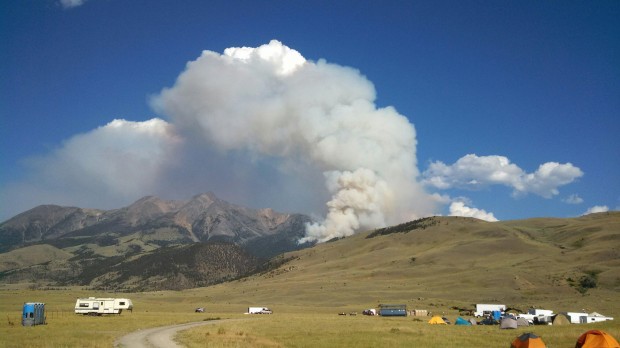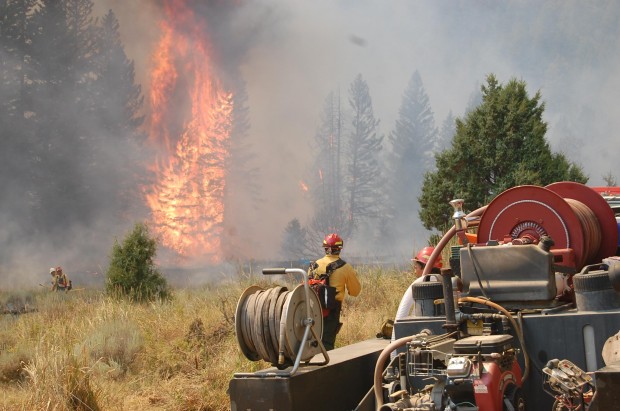Early last week, a Bozeman Daily Chronicle page 1 story raised the specter of fiery destruction at the hands of the sequester. The headline reads "Wildfire suppression efforts suffer under budget cuts." Local fires in what is collectively referred to as the Miner Paradise Complex fire were listed in a sidebar -- North Eightmile fire (containment at time of publication, none), Horsetail fire (containment, none), Emigrant fire (containment 5 percent), Sheep fire (containment, none), and also three fires in Yellowstone. All are lightening caused.
 |
| Emigrant fire smoke plume. |
Periodic and scattered fires regulate the availability of fuel and create natural fire breaks.
The Chronicle dutifully reported a press release put out by Obama's Secretary of Interior (with jurisdiction over the National Park Service).
On Wednesday, for the first time in five years, U.S. wildfire managers raised the national wildfire preparedness level to its highest point — Level 5 — based upon the high level of fire activity and the scarcity of fire suppression resources. This year, they're more scarce than usual.
“The decision to move to Preparedness Level 5 reflects the complexity facing our federal and non-federal fire managers… who will have to make tough decisions necessary to respond to the current workload,” said Department of the Interior Secretary Sally Jewell in a news release.
Attesting to the need, a dozen wildfires — most lightning-caused within the past week — now burn across Montana.Tough decisions, oh my! God forbid that any public sector employee be required to make one of those. We can't really expect anyone on the public payroll to do anything that's tough.
Obama's Secretary of Agriculture (jurisdiction over US Forest Service) is on the Obama scare train and is poor mouthing it too.
In February, Secretary of Agriculture Tom Vilsack informed the Senate that the $132 million in sequestration cuts to the Forest Service wildfire management budget meant that 500 fewer firefighters would be hired for the season. Fire commanders are feeling that pinch.
The primary strategy of the Forest Service is to suppress fires on initial attack. Fires that withstand initial attack now tend to grow larger, Vilsack told a Senate committee in June.That comes to $264,000 per firefighter -- for mostly seasonal work at that. It is what I call Obama cabinet math. According to the National Park Service firefighter pay ranges from about $10.00 per hour to over $17.00 per hour, depending upon the position and employee experience, which translates into a $21,000 to $35,000 a year full time, year around pay range. Sequester is all about cutting firefighters, right, sure Tom. Vilsack went to the same sequester math seminar that fed Education Secretary Arne Duncan's fabricated claim that 40,000 school teachers would be laid off, Defense Secretary Chuck Hegel's phony prediction of 21 day furloughs for civilian employees and Barack Obama's seminal rant that hundreds of thousands of jobs would be lost.
Getting back to our local fires, the Chronicle reported,
Fires can also burn longer because fewer people are available to fight them, said Miner Paradise Complex spokesman Jack Conner.
“The biggest issue is speed – fewer people can only go so fast when they're building a line. It's a race against time,” Conner said. “If the fire gets away, we have to refocus on initial attack again.”
Another problem with bigger fires is that fire crews have a 14-day work limit, after which they need time off. Many crews are running out of time with few to replace them, Conner said.
As a result, the Miner Paradise Complex is manned to a low level and the strategy is one of confinement rather than limited or full suppression.The newspaper made sure to get in a Prince Al Gore plug for climate change as well,
Over the past two decades, fire suppression costs have increased as more people moved into the wildland interface and climate change has caused fires to intensify.Not true at all. The intensity of fires increases because of trees, more trees and more trees, resulting from fire suppression.
Montana State University professor William Wyckoff calls it "tree invasion" in his book "On the Road Again."
In "On the Road Again," William Wyckoff explores Montana’s changing physical and cultural landscape by pairing photographs taken by state highway engineers in the 1920s and 1930s with photographs taken at the same sites today. The older photographs, preserved in the archives of the Montana Historical Society, were intended to document the expenditure of federal highway funds. Because it is nearly impossible to photograph a road without also photographing the landscape through which that road passes, these images contain a wealth of information about the state’s environment during the early decades of the twentieth century. To highlight landscape changes - and continuities - over more than eighty years, Wyckoff chose fifty-eight documented locations and traveled to each to photograph the exact same view. The pairs of old and new photos and accompanying interpretive essays presented here tell a vivid story of physical, cultural, and economic change.Wyckoff summarizes,
Most demonstrably, we observed the growth of forest cover in many of our views, including scenes from both western and eastern Montana. This thicker, more widespread forest cover widely visible across the state is no doubt one of the most geographically extensive cultural landscape changes apparent in Montana since 1920.
 |
| Tree Invasion 1921 (top) and 2002 photos, Wyckoff page 66, south of Livingston near local fires |
What has happened since the dire straights claims of the federal bureaucracy were laid out on Bozeman Daily Chronicle's page 1? The firefighters have done their usual brave and fantastic job, stepping in and protecting property where needed.
North Eightmile fire - As of 8/31 containment is listed at 17 percent and that is as far as it will go with very little fire activity -- unstaffed (crews and helicopter support withdrawn), daily aerial surveillance only. When crews were engaged they assisted a rocky ridge in preventing the fire from crossing the Gallitan Crest where it would have entered Bozeman Creek drainage, which is a source of drinking water for part of Bozeman. The Eightmile fire was largely naturally contained when it encountered the green re-vegetated burn of the 2001 Fridley fire. Here is a video of the smoldering remains which will continue to smoke until put down by the snows, usually in a mid-September to mid-October time frame.
Horsetail fire: The Horsetail fire is zero percent contained but hasn't grown beyond 143 acres. Aerial surveillance indicated little fire activity. Most of the trails that closed on consequence of the Horsetail Fire have reopened. There is a residual crew looking for hotspots -- snows eventually will do the rest.
Emigrant fire: This 10,770 acre fire is 56 percent contained.
Most importantly, structure assessments and protection efforts were finalized in the areas south of the Emigrant Fire as well as along the Mill Creek and Cedar Creek areas, earlier this week. It's now a essentially a pure natural wildfire with creep, smoldering and hot spots.Fire activity ranged from creeping and smoldering, to hot spots along the fire’s edge but remained minimal overall. Crews continued fire line construction and mop up along areas of the fire while placing direct handline on the southern edge of the fire and battling several hot spots.
Crews fighting Emigrant Fire 8/22
The number of personnel assigned to fight the fires is now down by more than half. Let it snow.
Sheep fire: The Sheep fire is 100 percent contained with crews efforts assisted by the need to clear out only "small portions of unburned fuel."
Down in Yellowstone National Park they learned their lesson when intense, galloping 1988 fires, fed by abundant fuels created courtesy of decades of fire suppression, burned almost 40 percent of the massive park in a single season and came within feet of destroying historic structures such as the Old Faithful Lodge. This year's fires are viewed as no big deal.
Visitors to Yellowstone may enjoy seeing wildfire play its natural role in the park Saturday and Sunday. Warm dry days should pep up fires that have lain and smoldered since receiving about a half inch of rain last week.
 |
| Alum Fire, Yellowstone National Park, 8/23 |
None of the six fires in Yellowstone Park poses a threat to visitors. Skies should be clear and pleasant through the holiday weekend. Hardly a wisp of smoke came from any fire in the park Friday, although smoke from distant California fires settled in some areas north of Yellowstone.
Still, sunshine and humidities in the teens may make for more obvious fire presence this weekend. As fire builds a bit of momentum, a few trees may catch fire in areas visible to visitors. The 7090 acre Alum Fire, south of the Mud Volcano area, showed little smoke Friday and has not grown in a week. If the fire eventually approaches Grand Loop Road, Park officials would coordinate a road closure, a short term inconvenience to visitors, much like closing the road for a bison herd.
The one acre Caldron Fire east of the Yellowstone River is also visible from Mud Volcano. Lightning started that fire Thursday afternoon, but on Friday, puffs of smoke were rare. The 155 acre Druid Fire lies high on a ridge a few miles north of the Northeast Entrance Road above the Lamar valley. A remote camera is monitoring the Druid Fire, which has been inactive in recent days. Three other fires have also shown little activity, but lookouts, fire monitors, and aircraft will observe them until enough rain or snow falls to end the fire season.
Yes, let 'em burn until it snows. Here's to hoping Sally Jewell doesn't realize her charges down in Yellowstone are operating against her narrative. We don't need a speech from Jewell saying she hopes no one works for Department of Interior who believes in forest fires.
Remember.
Remember.
Except you mostly shouldn't.


No comments:
Post a Comment